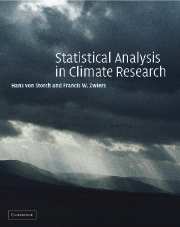1 - Introduction
Published online by Cambridge University Press: 03 February 2010
Summary
The Statistical Description and Understanding of Climate
Climatology was originally a sub-discipline of geography, and was therefore mainly descriptive (see, e.g., Brtickner [70], Hann [155], or Hann and Knoch [156]). Description of the climate consisted primarily of estimates of its mean state and estimates of its variability about that state, such as its standard deviations and other simple measures of variability. Much of climatology is still focused on these concerns today. The main purpose of this description is to define ‘normals’ and ‘normal deviations’ which are eventually displayed as maps. These maps are then used for regionalization (in the sense of identifying homogeneous geographical units) and planning. The paradigm of climate research evolved from the purely descriptive approach towards an understanding of the dynamics of climate with the advent of computers and the ability to simulate the climatic state and its variability. Statistics plays an important role in this new paradigm.
The climate is a dynamical system influenced not only by immense external factors, such as solar radiation or the topography of the surface of the solid Earth, but also by seemingly insignificant phenomena, such as butterflies flapping their wings. Its evolution is controlled by more or less well-known physical principles, such as the conservation of angular momentum. If we knew all these factors, and the state of the full climate system (including the atmosphere, the ocean, the land surface, etc.), at a given time in full detail, then there would not be room for statistical uncertainty, nor a need for this book.
- Type
- Chapter
- Information
- Statistical Analysis in Climate Research , pp. 1 - 16Publisher: Cambridge University PressPrint publication year: 1999
- 2
- Cited by

